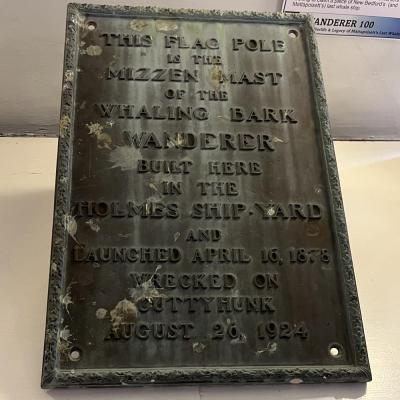New exhibit explores 100-year afterlife of Wanderer whaleship
MATTAPOISETT — A prodigious afterlife has followed the Wanderer since it wrecked on Cuttyhunk Island a century ago.
Not only did the ship’s material itself become souvenirs and keepsakes, but usage of the whaler’s likeness and name abound.
That legacy serves as the crux of a new exhibit at the Mattapoisett Museum. “Wanderer 100: The Afterlife of Mattapoisett’s Last Whaler” opened Thursday, July 11.
The artifacts on display tackle how the whaleship has been comprehensively commemorated, its “life in pop culture,” museum curator Connor Gaudet said.
The question of why the Wanderer has been so wholly remembered is tough to answer, according to Gaudet.
“The why is so hard to attack,” he said.
But people love firsts and lasts, and the Wanderer — the last whaleship built in Mattapoisett — serves as a symbol to the end of an era not just for the town but the entire whaling economy of New England, according to Gaudet.
The various items at the Mattapoisett Museum show how that symbol has manifested.
The exhibit chronicles early forms of tribute to the whaleship, like an advertisement for a shop named “The Wanderer” presented in a 1929 yearbook fittingly also titled “The Wanderer.”
Other relics include a card advertising “The Whaler Bar,” which operated from 1937 until at least 1969 in Midtown, Manhattan.
The bar’s interior aimed to replicate the captain’s cabin of a whaleship. The establishment’s owners insisted it was a faithful reproduction of the Wanderer, according to the Mattapoisett Museum.
Another section of the exhibit embodies how the Wanderer sailed across the globe prior to wrecking in 1924 by portraying objects in the museum’s collection that had been gathered from around the world.
The items were donated by whaling families and were picked up during times at sea, in locations the whaleship likely visited, according to the museum.
One of those artifacts is a “netsuke,” a small 18th-century animal sculpture from Japan.
“How in the world did this absolutely gorgeous carved ox make its way from Osaka, Japan to Mattapoisett?” Gaudet said.
For Gaudet, a notable item on exhibit is a Christmas tree ornament of the Wanderer, presented at the museum among a collection of other shipwreck-themed ornaments.
“That was just a fun way of looking at material culture and the odd ways we commemorate tragedy,” Gaudet said.















